This site is supported by our readers. We may earn a commission, at no cost to you, if you purchase through links.

From the daring peregrine falcons zipping through Chicago’s skyline to the bald eagles symbolizing freedom along the Mississippi River, Illinois offers a raptor show like no other.
Hawks like the red-tailed are keen hunters, while turkey vultures handle the dirty work as nature’s clean-up crew.
Whether you’re spotting an American kestrel, which often engage in hovering and perch-hunting techniques, hunting from a roadside wire or watching northern harriers in wetlands, these birds are essential to the ecosystem.
Curious to learn where you can spot these magnificent creatures and their unique behaviors? Stick around—there’s more to unravel!
Table Of Contents
- Key Takeaways
- Birds of Prey in Illinois
- Common Birds of Prey in Illinois
- Hawks in Illinois
- Owls in Illinois
- Where to Spot Birds of Prey in Illinois
- Conservation Status of Birds of Prey in Illinois
- Identifying Birds of Prey in Illinois
- Birds of Prey in Urban Areas
- Birds of Prey in Illinois’ Ecosystem
- Learning More About Illinois’ Birds of Prey
- Frequently Asked Questions (FAQs)
- Conclusion
Key Takeaways
- You’ll find a diverse range of raptors across Illinois’ varied habitats, from cityscapes to prairies.
- These birds play a crucial role in the ecosystem, controlling prey populations and acting as indicators of environmental health.
- You can improve your chances of spotting them by visiting specific locations, joining birdwatching communities, and learning key identification features.
- Many Illinois raptors face threats like habitat loss and pesticide use, highlighting the importance of conservation efforts.
Birds of Prey in Illinois
In Illinois, you’re never far from the thrilling sight of a majestic bird of prey gliding through the sky, thanks to the state’s rich mix of prairies, forests, and wetlands.
These raptors aren’t just fun to watch—they’re vital for keeping ecosystems balanced by controlling populations of small animals, and their presence is a sure sign of a healthy environment.
Overview of Illinois’ Raptors
Imagine gazing up at a clear Illinois sky, only to spot a majestic raptor slicing through the air.
These awe-inspiring birds of prey, or Illinois Raptors, thrive across diverse habitats, showcasing fascinating raptor diversity.
Whether it’s a hawk perched in a backyard or an eagle soaring over forests, bird watching in Illinois turns into an exhilarating game of hide and seek.
Importance of Birds of Prey in Illinois
Birds of prey in Illinois are like nature’s clean-up crew, balancing the ecosystem by controlling populations of rodents and other small animals.
They serve as critical biodiversity indicators, showcasing environmental health.
Plus, their role in raptor conservation is essential.
Spotting these majestic creatures at state parks or national wildlife refuges can leave you feeling inspired and connected to the wild.
Illinois’ Diverse Landscapes and Raptors
Illinois offers a scenic display of diverse landscapes perfect for raptors.
From prairies to forests, you’ll find everything from red-tailed hawks to great horned owls beautifully adapted to their environments, such as the red-tailed hawk’s rusty red tail sightings.
Each terrain shapes raptor habitat diversity, impacting how these majestic creatures hunt and thrive.
Keen observers might even spot a turkey vulture or a bald eagle soaring over areas like the Everglades and Merritt Island National Wildlife Refuge, which are popular eagle watching spots. Keen observers might even spot a turkey vulture or a bald eagle soaring.
It’s nature’s drama, live in Illinois!
Common Birds of Prey in Illinois
You’ll find a wide variety of fascinating birds of prey in Illinois, from the rooftop-nesting Peregrine Falcons of Chicago to the Turkey Vultures cruising over open fields.
These raptors add excitement to your wildlife watching but also play a key role in keeping the state’s ecosystems in balance.
Falcons in Illinois
Spotting falcons in Illinois always feels like catching sight of a superhero in action. The Peregrine Falcon‘s recovery story, nesting amidst skyscrapers, stands unique. Meanwhile, the American Kestrel can often be spotted on roadside wires, keenly hunting.
- Falcon migration patterns: a marvel
- Urban falcon adaptations: survival skills
- Falcon prey preferences: mice and small birds
- Falcon conservation efforts
- Bird of prey identification
Eagles in Illinois
Eagles in Illinois (Common Birds of Prey in Illinois)
Where can you see eagles in Illinois?
You’ll find Bald Eagles, majestic symbols of freedom, soaring near the Mississippi River, especially during winter.
If you’re fascinated by owl houses in Illinois, consider checking out local conservation stores like Owl House Illinois Gifts.
Eagle Sightings are common near water.
Their Eagle Diet consists mainly of fish.
Sadly, Eagle Conservation efforts are still needed.
Learning about Bald Eagle Nesting habits helps protect these incredible birds.
Keep an eye out for these powerful birds!
Vultures in Illinois
Amidst the changing landscapes of Illinois, vultures soar gracefully.
You’ll often see them in state forests, like the Black Vulture venturing further north.
These scavengers play a key role in the ecosystem by cleaning up carcasses.
Ever spotted one gliding over urban rooftops? It’s like nature’s cleanup crew!
Conservation efforts help them thrive, even as habitats shift.
Hawks in Illinois
When you’re in Illinois, spotting Red-tailed Hawks, the most common bird of prey in neighboring states like Michigan, with their distinctive reddish-brown tail, is a familiar sight. Spotting hawks soaring overhead is like witnessing nature’s very own air show.
These skilled hunters, ranging from the common Red-tailed Hawk to the unique Northern Harrier, will surely leave you captivated by their aerial acrobatics and sharp-eyed precision.
Common Hawks in Illinois
Exploring Illinois’ feathered hunters, common hawks bask in the state’s diversity like nature’s vigilant watchmen. With their impressive 4.5-foot wingspans, red-tailed hawk habitats vary greatly across North America. Imagine the red-tailed hawk soaring majestically, a familiar sight. With their adaptable nature and stealthy hunting techniques, including the ability to ambush prey from above, forest edge hunters, the Cooper’s hawk thrives among urban hawks. Can you spot a sharp-shinned hawk, known for its agile ambushes and sharp, high-pitched calls while in densly wooded habitats. Can you spot a sharp-shinned hawk flitting through wooded areas? Each hawk has a unique talent for adapting to its environment.
- Hawk Identification
- Hawk Habitat
- Urban Hawks
Unique Hawks in Illinois
You’ve seen the popular hawks; now let’s meet the unique hawks in Illinois.
The Northern Harrier impresses with its owl-like hearing, while the Rough-legged Hawk boasts feathers down to its feet—perfect for winter wanderings.
Check out their awe-inspiring features:
| Hawk Type | Unique Feature | Fun Fact |
|---|---|---|
| Northern Harrier | Owl-like hearing | Hunts like a ninja |
| Red-shouldered | Drops on prey from above | Stealthy and precise |
| Broad-winged | Epic migrations | Travels over 4,000 miles |
| Rough-legged | Feathers on feet | Loves cold climes |
| Conservation | Concerns exist | Preserving habitats is essential |
Northern Harriers in Illinois
In Illinois, Northern Harriers glide over fields like aerial detectives, using sharp hearing and keen eyesight to find prey.
Their preferred habitat is often wetlands, where they employ unique hunting techniques similar to owls.
Although their conservation status is stable, population trends can change with seasonal movements.
Harriers are both a mystery and a marvel in the prairie skies.
Owls in Illinois
In Illinois, owls bring a magical touch to the night with their eerie calls and ghostly silent flight.
From the familiar Great Horned Owl to the elusive Barn Owl, you’ll find a variety of these charismatic nocturnal hunters tucked away in forests and fields.
Common Owls in Illinois
Someone told me Illinois boasts some awesome owls! You’ll likely spot Great Horned Owls, masters of night hunting, across the state. Barred Owls prefer wooded areas, while Eastern Screech-Owls are adaptable and show up everywhere.
Their unique Owl Adaptations let them thrive.
- Listen for their distinctive Owl Sounds.
- Sadly, Habitat Loss threatens their homes.
- Conservation Efforts are essential for their survival.
- Learn to identify them to appreciate these amazing birds!
Rare Owls in Illinois
Even as you explore Illinois’ woods, finding a rare owl can feel like bumping into an old friend.
They face conservation challenges due to habitat changes.
Threats to Barn Owls are particularly worrying.
Identifying rare owls involves patience and luck.
Remember, every sighting helps in owl conservation efforts.
Who knew bird-watching could aid their survival?
| Owl | Habitat Loss | Conservation Efforts |
|---|---|---|
| Barn Owl | High | Urgent |
| Short-eared Owl | Moderate | Ongoing |
| Northern Saw-whet Owl | Low | Monitored |
Unique Characteristics of Illinois Owls
Curiosity piques, doesn’t it? Owls in Illinois boast some intriguing traits. Imagine this: 1. Their silent flight lets them sneak upon prey, leaving other animals none the wiser.
2. With sharp owl calls, they establish territories and attract mates.
3. Adaptations for nocturnal hunting give them an edge in the dark.
4. Then there are the unique nest sites, often reused year after year.
Where to Spot Birds of Prey in Illinois
You’ll find plenty of opportunities to spot majestic birds of prey right in your own backyard or at your local park in Illinois.
For a more thrilling adventure, head to places like Starved Rock State Park or Mississippi Palisades, where these raptors love to make an appearance.
General Locations for Birdwatching
You’ll find birds of prey in diverse spots around Illinois. Backyards are great for spotting hawks by your bird feeders, and consider installing a red-tailed hawk nest box to attract these birds.
Woodlands and forests are prime habitats for many species.
Near water bodies, look for eagles and osprey.
Open areas like fields host owls and vultures.
Join bird-watching communities to learn tips on birdwatching etiquette and rare sighting locations.
Specific Locations for Spotting Raptors
Ruffled by the beauty of nature? Try these raptor-watching hot spots in Illinois for an awe-inspiring experience.
Visit Starved Rock State Park for its best raptor viewing times in the spring.
Experience the top eagle nesting sites at Mississippi Palisades State Park.
Discover hidden raptor gems at Cache River State Natural Area.
For a glimpse into raptors, consider visiting the Illinois River in southwestern Illinois—it boasts impressive bird diversity, including bald eagle nests perched in towering trees.
Nature’s spectacle awaits!
Joining Bird-watching Communities
Ready to expand your birdwatching adventures?
Joining bird-watching communities in Illinois lets you connect with local experts, share knowledge, and enjoy birdwatching events.
These groups create a community impact through fun outings and conservation projects.
Imagine spotting a peregrine falcon amid shared laughter—an experience worth its weight in feathers!
Don’t fly solo; enjoy raptor-spotting with fellow enthusiasts.
Conservation Status of Birds of Prey in Illinois
You’ll find that the conservation status of Illinois’ birds of prey varies greatly, with some species thriving while others face challenges like habitat loss and pesticide exposure.
Learning about these threats and the ongoing conservation efforts is key to ensuring these magnificent birds continue soaring over our state for years to come.
Threats to Illinois’ Raptors
After spotting birds of prey in Illinois’ vibrant landscapes, you might wonder why some are harder to find.
Habitat loss, pesticide use, and climate change pose significant threats to their survival.
Like Wisconsin’s efforts to protect its diverse bird of prey population and ecosystem balance, Illinois can learn from Wisconsin’s conservation efforts.
Imagine an eagle’s view—seeing fewer open fields, struggling with lead poisoning, or dodging wind turbines.
It’s a tough gig being a raptor in today’s changing world!
Conservation Efforts in Illinois
You know, dealing with threats to raptors isn’t a small feat, but Illinois is swooping in with bold conservation efforts.
Habitat restoration plays a big role.
Tackling pesticide impact and understanding climate change effects are essential too.
Public education and volunteer opportunities invite you to be part of the change, making every feathered friend count!
Let’s cheer for our raptors!
Identifying Birds of Prey in Illinois
Spotting birds of prey in Illinois might feel like you’re on an exciting scavenger hunt, with majestic hawks, eagles, and owls hiding in plain sight.
By learning a few key traits and behaviors, you can start identifying these winged wonders with ease and maybe even impress your birdwatching friends!
Visual Identification of Raptors
Conserving these amazing creatures is essential, but recognizing them in the wild adds to the adventure.
To spot raptors, check out their impressive wingspan, unique field markings, and distinct beak shape.
Curious about their eye color? That can tell tales too, as you track them soaring with mesmerizing flight patterns.
Here are key features to focus on:
- Wingspan: Wide and striking.
- Field Markings: Unique patterns.
- Beak Shape: Sharp and distinctive.
Behavioral Identification of Raptors
Spotting raptors involves more than looks—think of it as watching a live nature documentary.
Raptors have fascinating flight patterns and hunting techniques.
Ever notice a hawk’s spiral ascent or an owl’s silent approach?
Their social interactions can be intriguing too, like when falcons swoop in synchronized pairs.
Meanwhile, their distinctive vocalizations help identify who’s who in the bird world.
Tips for Beginners
So, you’re ready to identify Illinois birds of prey? That’s awesome!
Start with a good field guide.
Next, grab your binoculars; they’re your best friend.
Finally, remember these tips:
- Note size and shape.
- Observe flight patterns.
- Check for key markings.
Bird identification is a journey, not a race! Have fun exploring!
Birds of Prey in Urban Areas
In bustling urban areas, you might spot a Red-tailed Hawk perched majestically on a city lamppost or see a Peregrine Falcon swooping between skyscrapers.
These raptors adapt easily to city life, often surprising residents with their talent for snagging pests like pigeons and rats, all while adding a bit of wild charm to the concrete jungle.
Adaptation of Raptors to Urban Environments
Think you’ve got city birds sorted? Well, guess what—raptors love a good urban challenge, with some species like Red-tailed Hawks thriving in urban habitats.
Urban hunting strategies help them nab prey amidst skyscrapers.
With homes atop bustling buildings, they’re pros at building nesting sites.
Noise doesn’t bug them much, though noise pollution impacts are real.
They often adapt food sources and master human-raptor interactions with flair.
| Urban Challenge | Raptor Adaptations |
|---|---|
| Tall Buildings | Building nesting sites |
| Noise Pollution | Reduced sensitivity |
| Varied Food Sources | Diverse diet adaptation |
Common Urban Raptors in Illinois
In Illinois, urban raptors like the Chicago Peregrine Falcons have made cityscapes their home.
Many residents have taken to using local bird feeders (Illinois bird feeders) to attract other bird species, while also inadvertently supporting the urban raptor ecosystem.
These birds expertly use tall buildings as urban nest sites, keeping an eye on abundant food sources in cities, such as pigeons.
Through clever urban raptor adaptations, they’ve become an integral part of city life, sparking curiosity and sometimes quirky human-raptor interactions.
Coexisting With Urban Raptors
Seeing a hawk in your yard feels like nature’s surprise gift.
Embrace their presence by ensuring urban raptor safety.
Avoid feeding them; it changes their natural feeding habits.
Secure nesting sites by checking roofs and eaves.
Reduce window collisions with decals.
Birds of Prey in Illinois’ Ecosystem
When you think of Illinois’ ecosystem, you might picture it as a delicate web, and birds of prey are the skilled acrobats keeping it all in balance.
These raptors aren’t just cool birds with fierce talons; they’re nature’s pest control managers, ensuring your backyard BBQ isn’t overrun with rodents!
Role of Raptors in Illinois’ Ecosystem
After spotting urban raptors, let’s chat about their broader role in Illinois’ ecosystem.
Raptors are nature’s balancing acts!
They’re not just feathered hunters; they symbolize freedom and power in managing ecosystem balance.
Their presence hints at raptor population trends and conservation challenges ahead, showing us how human-raptor interactions can impact environmental health.
Their keen eyes watch, guiding our understanding.
Impact of Raptors on Prey Populations
You’ll find raptors are key players in maintaining ecosystem balance.
Their hunting keeps prey populations in check, preventing overgrazing or depletion of certain resources.
Think of it as nature’s built-in pest control!
This predator-prey interaction is essential for population dynamics.
Without raptors, things could get seriously out of whack.
It’s a fascinating example of how interconnected wildlife really is.
Studying these interactions helps us understand the delicate balance of nature.
Raptors as Indicators of Environmental Health
Watching raptor populations soar or plummet offers insights into the environment’s health.
Think of them as nature’s canaries, reacting to changes like pesticide use, habitat loss, and water quality shifts.
Picture a hawk struggling due to climate change—it’s nature’s alarm bell ringing.
By observing these majestic birds, you’re tapping into an ecological "health report," so to speak.
Learning More About Illinois’ Birds of Prey
If you’re curious about Illinois’ birds of prey, there are plenty of engaging activities to fuel your interest.
From participating in bird-watching tours to joining citizen science projects, you’ve got lots of ways to connect with these amazing raptors and contribute to conservation efforts.
Bird-watching Tours and Workshops
Join bird-watching tours in Illinois.
Embrace your inner explorer and join local experts on these adventures.
You’ll learn fascinating beginners tips on identifying raptors in their natural habitat, and discover unique species such as the Great Blue Heron habitats.
Brush up on tour etiquette and photography basics to capture those fleeting moments.
With a conservation focus, these workshops offer a fun way to support the environment while delving into nature’s wonders.
Citizen Science Projects in Illinois
Bird-watching tours spark curiosity, but Citizen Science Projects in Illinois let you get hands-on.
Imagine raptor monitoring, where you help with data collection and habitat mapping.
Maybe try nest surveys to contribute to ongoing conservation efforts.
You’re not just spotting these majestic birds; you’re part of preserving their future.
So grab your binoculars and join the adventure!
Frequently Asked Questions (FAQs)
What threats do Illinois birds of prey face?
Illinois birds of prey face threats like habitat loss, pollution, and human disturbances.
Illegal hunting and pesticide exposure also harm these raptors.
Protecting natural spaces and controlling chemical use help guarantee these majestic birds thrive for future generations.
How can I help protect Illinois raptors?
Picture yourself as a silent guardian.
Report injured raptors to wildlife centers.
Support conservation groups.
Create safe habitats in your backyard.
Educating others about these majestic creatures helps them survive and thrive in Illinois’ diverse landscapes.
Which birds of prey are easiest to identify?
You can easily spot Red-tailed Hawks with their distinct reddish tails and broad wings.
Bald Eagles stand out with white heads and tails.
Turkey Vultures are known for their dark bodies and V-shaped flight pattern.
Do all Illinois raptors migrate?
Not all Illinois raptors migrate.
Some like the Great Horned Owl and Red-tailed Hawk stick around year-round.
But others, like the Broad-winged Hawk, can’t resist the call of warmer places during cooler months.
Where can I find bird of prey photos?
Like finding treasure in an attic, finding bird of prey photos is easy!
Check photo-sharing websites like Flickr or the Audubon Society website for high-quality images.
Local libraries often have stunning photography books too.
Conclusion
Think of Illinois birds of prey as the characters in a grand story of survival and balance.
You might eye them swooping through Chicago’s skyline or patrolling the Mississippi skies.
They’re essential guardians of the ecosystem, showcasing adaptability and beauty.
By exploring their world, you contribute to their conservation and understand nature’s delicate balance.
So, get ready to explore the thrilling narrative of Illinois’ winged hunters—every sighting is a chapter worth examining!

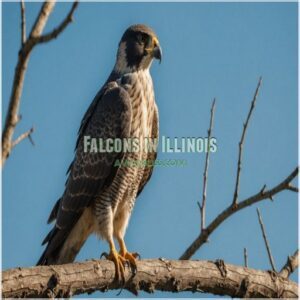
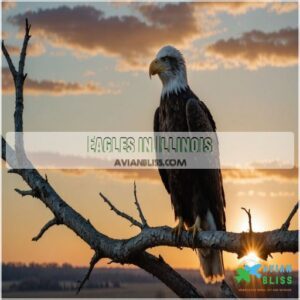

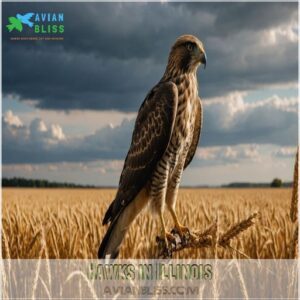
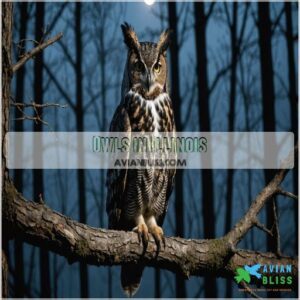

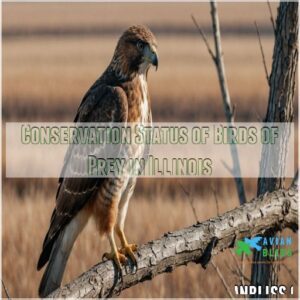
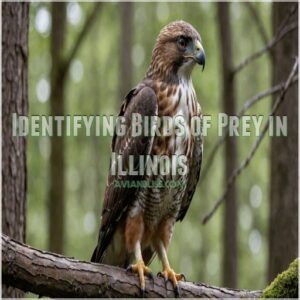
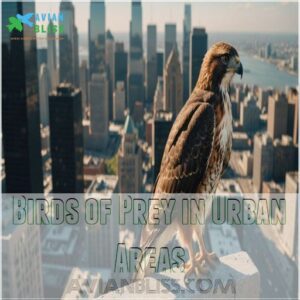

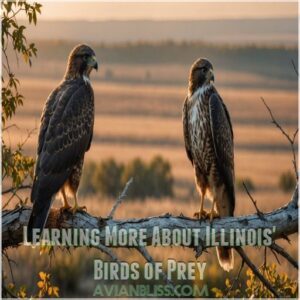
0 Comments